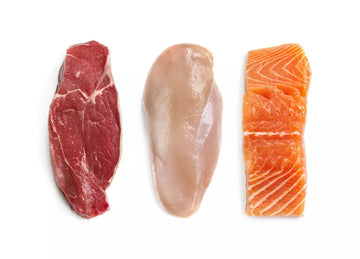Imagine having to eat the same meal every day for the rest of your life. No variety, no new flavors, just the same food day in and day out. As monotonous as it sounds, this is essentially what many of us do with our dogs when it comes to their food. We often pick a single brand and flavor of dog food, expecting it to provide all the necessary nutrients and excitement our dog needs for their entire life. While consistency in feeding isn't inherently bad (as long as your dog is getting the nutrients they need), some pet nutritionists advocate for an approach known as "rotation feeding."
In this article, we'll explore what rotation feeding is, why it's beneficial for your dog, and how you can easily implement it into your pet’s routine.
What Is Rotation Feeding?
Rotation feeding is exactly what it sounds like—it’s all about giving your dog a variety of foods rather than sticking to just one brand or flavor for their entire life. It is a nutritional and holistic approach to feeding that mirrors the diet of a dog’s wild ancestors, the wolf, who eats a variety of foods in the wild. Unlike a strict diet regimen that relies on the same kibble or wet food daily, rotation feeding introduces different proteins, grains, and even vegetables into your dog's meals on a rotating basis.
In essence, rotation feeding provides more diverse nutrition, helps prevent boredom, and can also contribute to overall better health for your dog.
Why Should You Rotate Your Dog’s Diet?
If you're wondering why rotation feeding matters, the answer lies in the potential benefits it offers. Just as a well-rounded human diet requires a variety of foods to get all the necessary nutrients, your dog also benefits from having multiple sources of nutrition. Dogs, much like us, need a range of vitamins, minerals, proteins, and fats that come from different food sources. Offering your dog only one type of food may result in a less-than-ideal balance of nutrients over time. With rotation feeding, you're able to provide a broader nutritional profile and, consequently, a more complete diet.
Let’s dive into the specific benefits of rotation feeding and why more pet owners are choosing to incorporate it into their dog's nutrition.
1. More Complete Nutrition
Many dog foods on the market claim to offer a "complete and balanced" diet, but the reality is that no single food can provide every nutrient in perfect proportions. Even though various ingredients may contain the same essential vitamins, minerals, and nutrients, they do not always deliver the same levels of those nutrients.
Take protein sources as an example. Both beef and salmon are excellent sources of protein, but they each offer different nutritional benefits. Beef is high in iron and relatively low in cholesterol compared to salmon, which is rich in Omega-3 fatty acids and contains less saturated fat. By rotating between different protein sources, such as beef, chicken, lamb, and fish, your dog will benefit from a more diverse nutrient intake, which can enhance their overall health.
Additionally, many commercial dog foods are supplemented with synthetic vitamins and minerals to compensate for the nutrients lost during food processing. While these supplements are helpful, they can’t always match the bioavailability of nutrients found in whole foods. Rotation feeding provides a more natural way for your dog to get a well-rounded intake of nutrients.
2. Increased Excitement at Mealtime
Feeding your dog the same food every day can lead to disinterest or even refusal to eat, especially for dogs that tend to be picky. Just like humans, dogs can grow bored of repetitive meals, and for some dogs, this boredom manifests in picky eating behavior. While some picky eating might be due to underlying health issues, a lot of the time it’s simply a harmless but frustrating quirk of their personality.
Rotation feeding can help remedy this by introducing new flavors and textures into your dog’s diet regularly. When you change up the protein or brand of food you’re feeding, it’s like a whole new experience for your dog, keeping them engaged and excited to eat. The novelty of new food can reignite their interest in mealtime, reducing the chances of them turning up their nose at their bowl.
Additionally, rotating foods may stimulate your dog’s appetite. By offering a variety of meals, you might encourage your dog to eat more regularly and with enthusiasm, which is particularly beneficial for dogs who are naturally picky or have reduced appetites due to age or illness.
3. Reduced Risk of Food Allergies
Food allergies are a growing concern in dogs, and they often develop after prolonged exposure to specific ingredients in their food. Common allergens for dogs include beef, chicken, corn, wheat, soy, and dairy. Since many dogs are fed the same brand and type of food for extended periods, they are more likely to develop sensitivities to these ingredients over time.
Rotation feeding can help minimize the risk of food allergies by preventing overexposure to any one ingredient. By frequently changing the primary protein or carbohydrate in your dog’s meals, you can lower the chances of your dog developing an intolerance or allergy. If your dog is already allergic to certain ingredients, rotation feeding also allows you to eliminate these allergens while still providing variety.
For example, if your dog develops a sensitivity to chicken, you can rotate to novel protein sources like duck or venison to help prevent further allergic reactions.
4. Improved Digestive Health
Dogs, like humans, can benefit from a diverse diet when it comes to digestion. Feeding a single type of food for years can result in your dog developing a sensitive stomach when exposed to new foods. Rotation feeding helps build a more resilient digestive system by exposing your dog to a wider variety of proteins, carbohydrates, and fiber sources.
By rotating through different foods, your dog’s digestive system is more likely to remain robust and capable of processing various ingredients without distress. Additionally, the variety in fibers found in different foods can promote healthy gut bacteria, which is essential for good digestion and nutrient absorption.
5. Balanced Fatty Acids for Healthy Skin and Coat
Omega-3 and Omega-6 fatty acids are essential for your dog’s skin and coat health. However, different foods contain different amounts of these fatty acids, and not all foods offer an ideal balance between the two. For instance, salmon is rich in Omega-3s, which are known to reduce inflammation and improve coat quality, while chicken provides more Omega-6s, which are important for maintaining skin elasticity.
Rotation feeding ensures that your dog is getting a balanced intake of these fatty acids, which can result in a shinier coat, healthier skin, and reduced itchiness or inflammation. This is particularly beneficial for dogs prone to dry or flaky skin.
6. Supports a Healthy Weight
Weight management is crucial for your dog’s overall health, and rotation feeding can play a role in maintaining a healthy weight. Dogs that eat the same food every day may overeat out of boredom, leading to weight gain. By switching up their meals, you can keep your dog engaged and help prevent overeating.
Additionally, some dog foods are higher in calories or fat than others. By rotating between different types of food, you can manage your dog’s calorie intake more effectively, preventing both weight gain and weight loss.
7. Mental Stimulation
Mealtime isn’t just about physical nourishment; it’s also an opportunity to stimulate your dog mentally. Dogs are natural scavengers, and in the wild, they’d spend much of their time foraging for food. While domesticated dogs no longer need to hunt for their meals, you can still satisfy their natural instincts by making mealtime more exciting.
Incorporating new foods, textures, and even puzzle feeders can provide a mental workout for your dog. The variety in food keeps their brain engaged and helps stave off boredom, which is particularly important for high-energy or intelligent dog breeds.
6. Incorporate Fresh and Whole Foods
While many commercial dog foods offer a complete and balanced diet, incorporating fresh, whole foods into your dog’s rotation feeding plan can provide an extra boost of nutrients. Fresh ingredients such as boiled chicken, cooked vegetables, plain yogurt, or even small amounts of cooked fish can introduce a variety of textures and flavors into your dog’s diet. These additions can be especially beneficial for picky eaters or dogs who need additional nutritional support.
Some pet owners also choose to feed their dogs a raw diet or include raw ingredients, like raw meat and vegetables. If you decide to go this route, it’s crucial to follow proper food safety guidelines and ensure that the raw food is balanced. Consulting with a vet or a pet nutritionist is highly recommended before incorporating raw food into your dog's diet.
7. Utilize Seasonal Ingredients
Just as human diets often change with the seasons, you can use the same approach for your dog’s diet. In the colder months, you might introduce more warming foods like lamb, beef, or turkey. In the summer, lighter proteins like fish or chicken may be more appropriate, along with fresh fruits and vegetables such as blueberries, carrots, and green beans.
Using seasonal ingredients can provide not only nutritional variety but also align with what is most readily available and fresh. Plus, many seasonal ingredients are rich in antioxidants, which can help boost your dog’s immune system.
8. Tailor the Rotation to Your Dog’s Age and Activity Level
When implementing rotation feeding, consider your dog's age, activity level, and specific health needs. Puppies, adult dogs, and senior dogs all have different dietary requirements, so their rotation feeding plan should reflect that.
For example:
- Puppies may require higher protein and calorie content to support their rapid growth. Rotation feeding with various protein sources like chicken, fish, and lamb can ensure they get the essential amino acids for development.
- Adult dogs generally need balanced meals to maintain their health and energy. Rotating between a variety of proteins and adding fiber-rich ingredients can help support healthy digestion.
- Senior dogs may benefit from foods that are easier to digest and lower in fat. You might rotate leaner proteins like turkey or fish while avoiding high-fat options to manage their weight and reduce the risk of arthritis or other age-related conditions.
Additionally, active dogs or working dogs that burn more calories will need higher-calorie foods, while less active dogs or those prone to weight gain may need lighter options. Rotation feeding can help you manage these needs effectively by adjusting food types based on your dog's activity level.
9. Monitor Your Dog’s Health and Adjust Accordingly
One of the keys to successful rotation feeding is to observe how your dog responds to new foods. Not every food will work for every dog, and some ingredients may not sit well with your dog’s digestive system. Keep an eye on their stool, energy levels, coat quality, and any signs of allergies or sensitivities, such as itching, vomiting, or diarrhea.
If you notice any adverse reactions, it’s important to adjust the rotation plan. You can eliminate problematic ingredients and focus on foods that work well for your dog. For instance, if your dog shows signs of a chicken allergy, you can rotate with proteins like fish, lamb, or duck instead. Remember that rotation feeding doesn’t have to be rigid—flexibility is essential to finding what works best for your dog.
10. Stay Consistent with Meal Timing and Portions
While rotation feeding introduces variety in the food itself, it's important to maintain consistency in meal timing and portion sizes. Dogs thrive on routine, and having regular feeding times helps regulate their digestion and energy levels. Whether you feed your dog once or twice a day, make sure to stick to a consistent schedule.
Additionally, adjust the portion sizes based on the type of food you are feeding and your dog’s activity level. Some foods, particularly those high in fat or calories, should be fed in smaller portions, while leaner foods might require larger servings. Always check the feeding guidelines provided on the packaging and consult with your veterinarian to ensure you're giving the right amount of food for your dog's specific needs.
11. Rotate Treats and Chews Too
Rotation feeding isn’t just for your dog’s main meals—you can also apply the concept to treats and chews. Just as with food, offering the same treats day after day can lead to boredom and, in some cases, contribute to overexposure to specific ingredients that could cause allergies.
There are many healthy, dog-friendly treats available that come in various flavors, textures, and ingredient types. By rotating treats made from different proteins or plant-based options like sweet potatoes, you can offer variety while still ensuring your dog’s diet remains balanced. This also helps reduce the likelihood of your dog becoming picky about treats or, worse, refusing them altogether.
12. Work with a Veterinarian or Pet Nutritionist
If you're new to rotation feeding or have concerns about your dog's specific dietary needs, it's always a good idea to consult a veterinarian or pet nutritionist. They can help you design a rotation feeding plan that works best for your dog’s health, lifestyle, and any specific conditions they may have.
For example, if your dog suffers from gastrointestinal issues, a nutritionist might suggest starting with limited-ingredient foods and slowly introducing new ingredients into the rotation to monitor how well your dog tolerates them. On the other hand, if your dog is overweight, your vet may recommend rotating lower-calorie foods to support weight management.
A professional’s guidance ensures that your rotation feeding plan is balanced and suitable for your pet, helping you avoid common pitfalls like nutrient imbalances or digestive upset.
How to Implement Rotation Feeding
Introducing a rotation feeding plan doesn’t have to be complicated, but it does require some thought and planning. Here’s how to get started:
-
Start Slowly: If your dog has been eating the same food for a long time, introduce new foods gradually to avoid digestive upset. Mix small amounts of the new food with their current food, gradually increasing the ratio over a week.
-
Rotate Proteins: Focus on rotating different protein sources like beef, chicken, fish, and lamb. You can also try more novel proteins such as venison, duck, or rabbit, especially if your dog has known allergies.
-
Alternate Brands: Consider rotating between reputable dog food brands. Each brand uses slightly different formulas, even if they have similar ingredients, which adds variety to your dog’s diet.
-
Include Wet and Dry Food: Mixing wet and dry food can provide more variety in texture and moisture content. You can rotate between dry kibble, wet food, and even fresh or raw dog food.
-
Consult Your Vet: If your dog has specific dietary needs or health concerns, it’s important to consult with your veterinarian before starting rotation feeding. They can help you choose the best foods and ensure your dog is getting all the nutrients they need.




